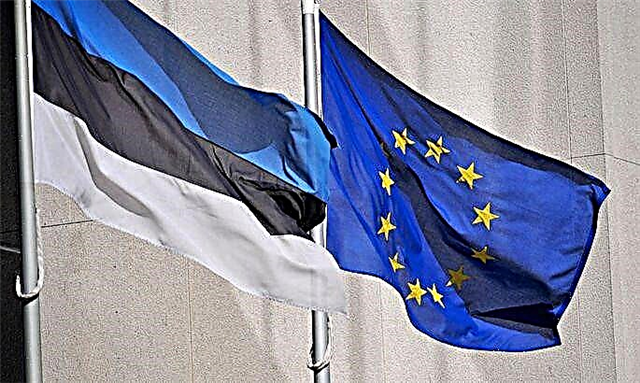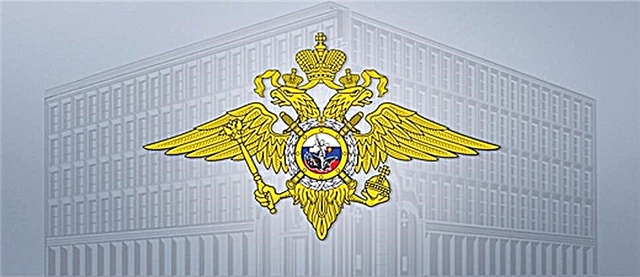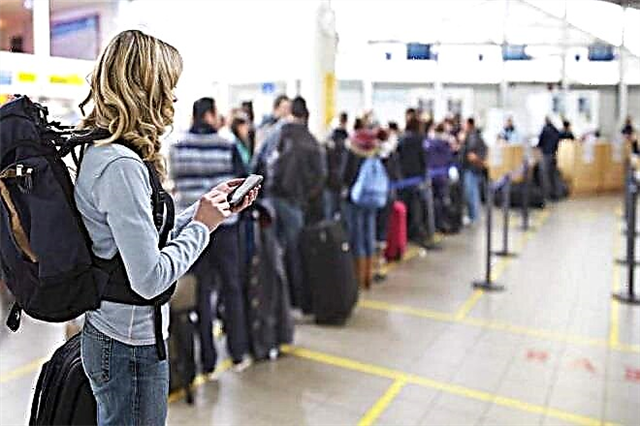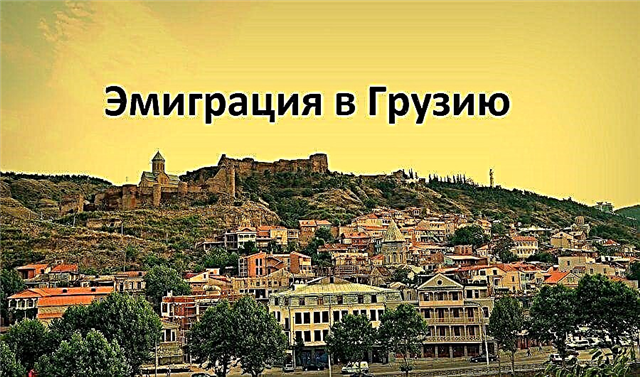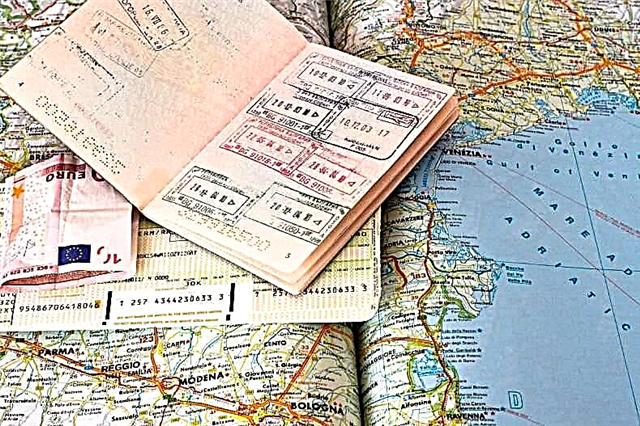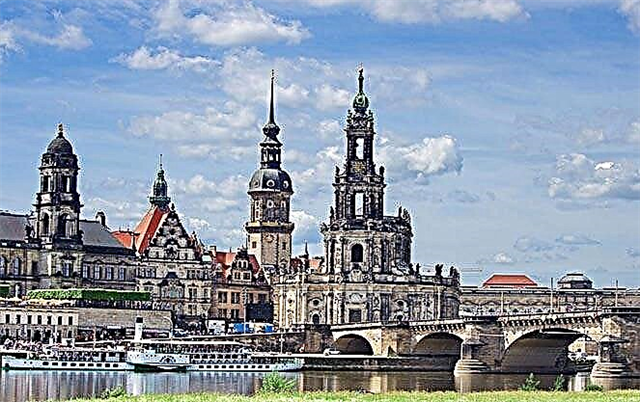Many churches, cathedrals and mosques in Dresden keep important historical events behind their walls. A large number of religious buildings are concentrated in this city, which impress with their appearance and interior decoration.

The magnificent Frauenkirche
The Frauenkirche was erected in Dresden at the behest of the then king of Poland and Saxony, Augustus the Strong. Translated into Russian, the name sounds like the Temple of the Mother of God.

The church building was destroyed to the ground during the Second World War. The Frauenkirche managed to start restoring it only in the 90s of the XX century.
The interior of the church impresses with its solemnity. The walls are painted with a special kind of paint, which was prepared according to old recipes. One gets the impression that the temple is glowing from the inside.
The baroque altar, decorated with gold, attracts special attention of tourists.
Kreuzkirche - the main Protestant church in the city
The Kreuzkirche temple is located on the southeast side of the old market. One building harmoniously combines Gothic, later Baroque and elements of classicism. This temple is one of the most visited historical sites in the city.

During its dramatic centuries-old history, the Kreuzkirche burned down and was destroyed several times. When the city was founded, a chapel stood on the site of the temple, instead of which the Romanesque chapel of St. Nicholas was built in 1215.
- In 1234, Margrave Heinrich presented the temple with a fragment of the Cross, on which, according to legend, the Savior was crucified. In honor of this relic in 1388, the church was named Kreuzkirche - Church of the Cross.
- In 1491, the temple burned for the first time. Only 40 years later, it was restored, but in the Gothic style.
- The seven-year war with Prussia also did not bypass the Kreuzkirche. In 1760 the building was badly damaged. The restoration work lasted 32 years and ended only in 1792.
- The fire of 1897 almost completely destroyed the church, after three years it was rebuilt. Now its 92-meter tower was adorned with five bells.
- In February 1945, Kreuzkirche came under an air raid. Only the outer walls and the tower were partially preserved.
- The temple was rebuilt in 1955.
- In 1963, a new organ was installed in the church. Not only services are held here, but also organ music concerts. Many people visit this temple on Christmas Eve, when the world-famous Kreuzkirche choir of boys and young men sings at the service.
The Church of the Holy Cross is open every day. Opening hours: from 10.00 to 17.00. Free admission.
You can climb to the observation deck and the tower from 11.00 to 15.00 (the last climb is carried out half an hour before the tower closes).
The rise is paid:
- adults - 4 euros;
- pupils and students - 2.5 euros;
- children under 14 years old - 1 euro;
- family ticket - 6 euros.
You can get to the temple by taxi or by tram (No. 8, 9, 11, 12). You will need the Prager Straße stop. The church is located at: An der Kreuzkirche, 1.
The largest church in Saxony, the Hofkirche
The Dresden Hofkirche was erected by the architect Gaetano Chiaveri. The Baroque court church was built when Frederick August II of Saxony, the legitimate son of Augustus the Bold, became the elector. The construction took 16 long years.

It was erected simultaneously with the Frauenkirche, being only 300 meters from the Protestant "neighbor". The temple cost the city treasury more than 900 thousand thalers. The four small bells in the bell tower did not ring until 1806 by order of the Catholic Napoleon, when he declared Saxony a kingdom.
In the church, consecrated with the name of the Holy Trinity, there is a copy of the icon of Andrei Rublev, which is located next to the altar. The building of the temple was badly damaged during the bombing of 1945, but did not turn into ruins, like many other buildings.
Perhaps it was the Holy Trinity that saved the church building from complete destruction. After the end of the war, the inhabitants of the city quickly restored the temple; the first service was held in it already in 1947. The church was completely rebuilt in 1962.
49 members of the Wettin dynasty, who ruled Saxony for several centuries, rest in the underground of this temple.
The bishops of the Catholic diocese of Dresden-Meissen are also buried here in their sarcophagi.
Dresden Cathedral impresses with its interior decoration. One of the main decorations is the organ by Gottfried Silbermann.
The altar is made of gilded bronze and marble, decorated with a canvas by Anton Raphael Mengs "Ascension of Christ".
The nave is decorated with 3-meter-high figures of 78 saints, a magnificent bell tower was erected on it. One of the side chapels bears a Meissen porcelain pieta dedicated to the victims of the bombing.
The cathedral is located on Palace Square, not far from the opera house, at the address: Schloßstraße, 24, 01067.
You can get to the cathedral by tram number 4, 8, 9 (Theaterplatz stop).
Free admission. Temple opening hours:
- Monday and Tuesday - 9.00-18.00;
- Wednesday and Thursday - 9.00-17.00;
- Friday - 13.00-17.00;
- Saturday - 10.00-17.00;
- Sunday - 12.00-16.00.
Church of the Three Wise Men - the oldest city temple
The Church of the Three Wise Men is a Dresden church associated with the name of Augustus the Strong. A medieval Gothic church existed here already in 1403. The temple was constantly upset and decorated.
In 1539 it had five altars. A fire in 1685 completely destroyed the building. However, the parishioners erected a new Church of the Three Wise Men of even more impressive dimensions in just 3 years.

Only the building did not fit into the city plan, because it blocked the street and violated the central perspective. For this reason, in 1703, the restored church was dismantled, but they promised to rebuild it at the expense of the city treasury.
The church turned out to be very beautiful. The majestic 87-meter bell tower is decorated with human-sized sculptures of three wise men and four evangelists.
Since 1991, the church has housed a 16th century art monument - Dresden's "Dance of Death" by Christoph Walter. The length of the "Dance of Death" is 12 m, and the width is 1 m 20 cm. The skeleton leads 24 groups, which bring together people from different social strata of the 16th century: from the emperor to the commoner.
The altar of the temple was created in 1732 by Johann Benjamin Thomae. On it you can see the parable of the ten virgins, sculptures of the holy apostles John and Matthew.
In addition, traces of the bombing were preserved on the altar, which the townspeople did not restore for the edification of future generations.
In the eastern part of the temple is the Church House, where there is a banquet hall, offices and various auditoriums.
The Church of the Three Wise Men is located at Hauptstraße, 23. You can get to the temple by trams No. 4, 8, 9 - stop Neustadter Markt, No. 3, 6, 7, 11 - stop Albertplatz.
The entrance to the church is free. A visit to the observation deck costs 1.5 euros (with a discount - 1 euros).
The temple and observation deck are open:
- in the summer season (March - October) - on Tuesdays (11.30–16.00), Wednesdays and Saturdays (11.00–17.00) and Sundays (11.30–17.00);
- in the winter season (November - February) - on Wednesdays (12.00-16.00), Thursdays and Fridays (10.00-16.00), Sundays (11.00-16.00).
Information about the concerts that take place within the walls of the temple can be found on the official website.
Martin Luther Evangelical Lutheran Church
This church was built in Dresden in 1833-1877 on the small Martin-Luther-Platz. The building seems to be simply huge in comparison with the neighboring buildings. Like many Protestant churches of the period, it is distinguished by a mixture of neo-Gothic and neo-Romanesque elements. Scenes from the life of Christ are presented on old stained glass windows. The observation tower offers an incredible view of the city.

You can get to the church by tram number 11. You need to go to the Pulsnitzer Straße stop. Detailed information about the church can be viewed on the website.
Church of st.Lucas - the building with the best acoustics in the world
The Church of St. Lucas is a Protestant church in the Saxon capital. The temple was consecrated in the name of the Holy Apostle Luke - the author of one of the four Gospels.
The church was designed by Georg Weidenbach. The facade of the building was created in the style of historicism, the interior decoration is dominated by Art Nouveau. In 1908-1933, Johann Kessler, a former mentor at the court of Emperor Wilhelm II, served as chaplain of the church.

And this church building was seriously damaged during the 1945 air raid. The dome and the altar part were destroyed.
After the war, the building was partially restored, but thanks to its excellent acoustics, it was used only as a recording studio and a venue for classical concerts.
At various times, the Berlin Philharmonic Orchestra under the direction of Herbert von Karajan sounded in the Church of St. Lucas. Other musical groups also performed here. Divine services began to be held only in 1972.
All information about the church can be found on the official website.
Annen Church in Dresden
The Annen Church was named after the founder, Elector Anne. It was built in 1578. Located outside the city center.

The church building was almost completely destroyed during the Seven Years War, and it was restored several years later.
But during the Second World War, the church was practically not damaged. About 1000 people were saved within the walls of the church during the air raid.
City synagogue
The main synagogue of the city was built in the 1840s by the architect Semper. In 1938 it was burned down by the Nazis. A small synagogue was erected in the Jewish cemetery, where Jews came to pray.
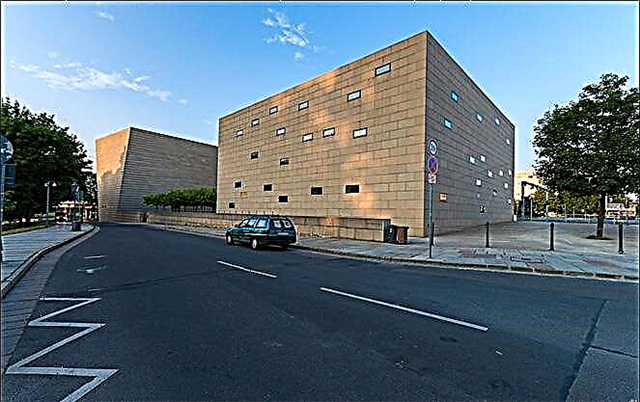
The Jewish population of Dresden increased and it became necessary to build a new synagogue. They decided to erect the building on the site of the destroyed one.
The modern synagogue is shaped like a cube. The building is famous for the fact that it was erected from scratch, which is not typical for other religious buildings in Dresden.
The synagogue is located at Hasenberg 1, 01067. For more information, call +49 351 65 60 710 or visit the website.
Russian Orthodox Orthodox Church of Simeon Divnogorts
The Temple of Simeon Divnogortsa belongs to the Berlin-German Diocese of the Russian Orthodox Church. In Germany, in many cities there are churches or parishes belonging to this diocese, for example, the parish of the Holy Life-Giving Trinity in Dortmund; there are more than 100 Russian churches in total.

For more than half a century (after 1813), the temple of Simeon Divnogorets changed addresses, existing as a home church. I.S. Turgenev.
Here in 1863 Pyotr Arkadyevich Stolypin was baptized, who was born in Dresden, and in 1870 - Dostoevsky's daughter Lyubov Fedorovna.
For a long time the Orthodox church would have roamed if the Russian citizen A.F. Wolner did not give away a plot of land on Reichenbachstrasse in the most prestigious part of the city for the construction of a church building.
The architect von Bossset developed the external and internal design of the temple free of charge. The foundation of the church was laid on April 25 (May 7) 1872.
The temple was consecrated by Archpriest Mikhail Raevsky on May 24 (June 5) 1874. The Russian nobility gave generous donations to the church. Composer Sergei Rachmaninov donated a large sum for the gas heating device.
The building was damaged after an air raid on February 13, 1945. However, services in the church continued. In the summer of 1945, the temple was transferred to the Western European Exarchate of the Russian Orthodox Church.
Two commemorative plaques hang on the walls of the temple. One plaque tells about the time of the foundation of the church and the people who took part in it, while the other keeps the memory of Alexander II, who visited here in June 1875.
The icon and the cross of the Resurrection of Christ were donated by the Jerusalem Patriarch Nicodemus.
Two more icons of the holy Reverend Simeon Divnogorets were donated to the church by M.N. Zhuravlev. They have been specially sized for the left and right sides.
You should definitely pay attention to them, because these images are not just a work of art, but also an impulse of spiritual generosity. Saint Equal-to-the-Apostles Princess Olga and Saint Nicholas the Wonderworker look at visitors from the icons. The altarpiece of the Ascension of the Lord in human growth is written right on the glass.
The temple is located at Fritz Löffler Straße, 19 (phone +49 351 471 9414). It is located 5 minutes walk from the railway station and 15-20 minutes from the Old Town.
The church is open every day, except Monday, from 10.00 to 17.00. On Monday, the temple opens its doors to visitors at 12.00. Free admission. Photography within the walls of the church is prohibited.
Those wishing to learn more about the history of the Russian Church in Germany can agree on an excursion with the Father Superior, if a group of 10 or more people has gathered. For the service, you must bring a donation to the temple in the amount of 1 euro from each participant.
Outcome
There are many churches and cathedrals in Dresden, which are not only religious shrines, but also historical monuments. Almost all of them were badly damaged during the bombing of 1945, but were restored by the city authorities and residents.
The most famous is the Church of Our Lady - the Frauenkirche Church.
The Church of the Lord's Cross is especially visited during the Christmas holidays, when the angelic voices of the Kreuzkirche boys and youth choir sound there.
The Church of the Three Wise Men, the oldest temple in the city, also attracts attention. Concerts are often held within the walls of this church, the schedule of which can be viewed on the website. St. Lucas Church is known for its incredible acoustics.
The Temple of Simeon Divnogorets is a Russian Orthodox church, among the parishioners of which were prominent figures of Russia.
There is also a working synagogue in the city.

